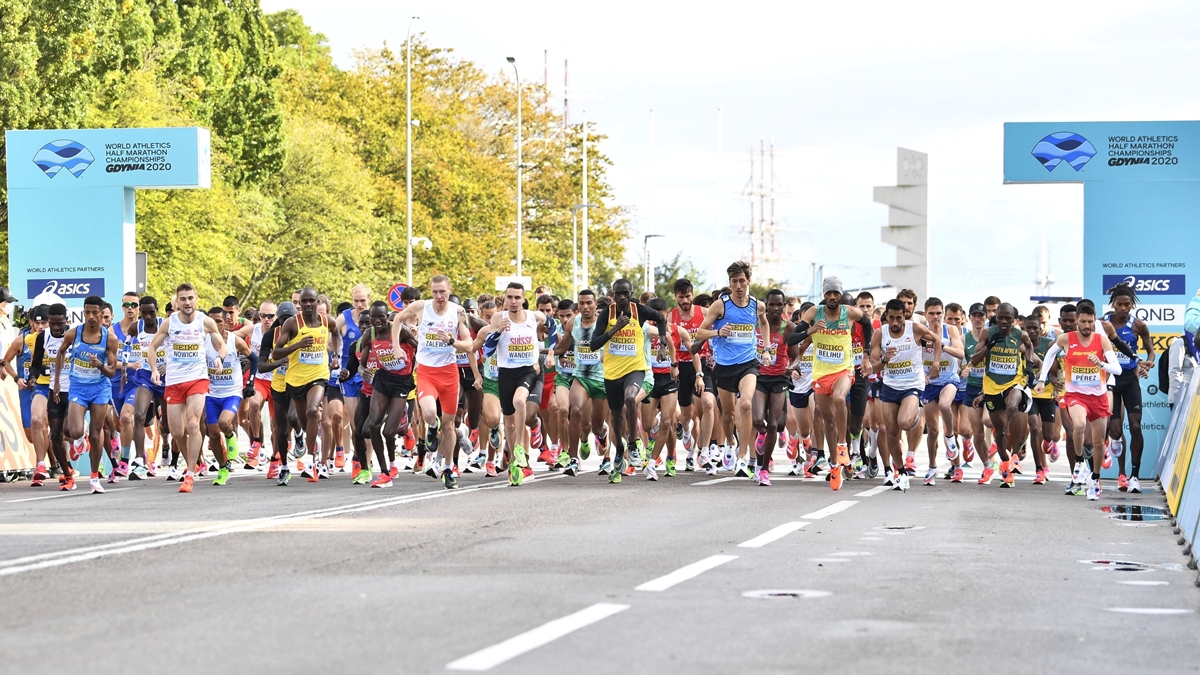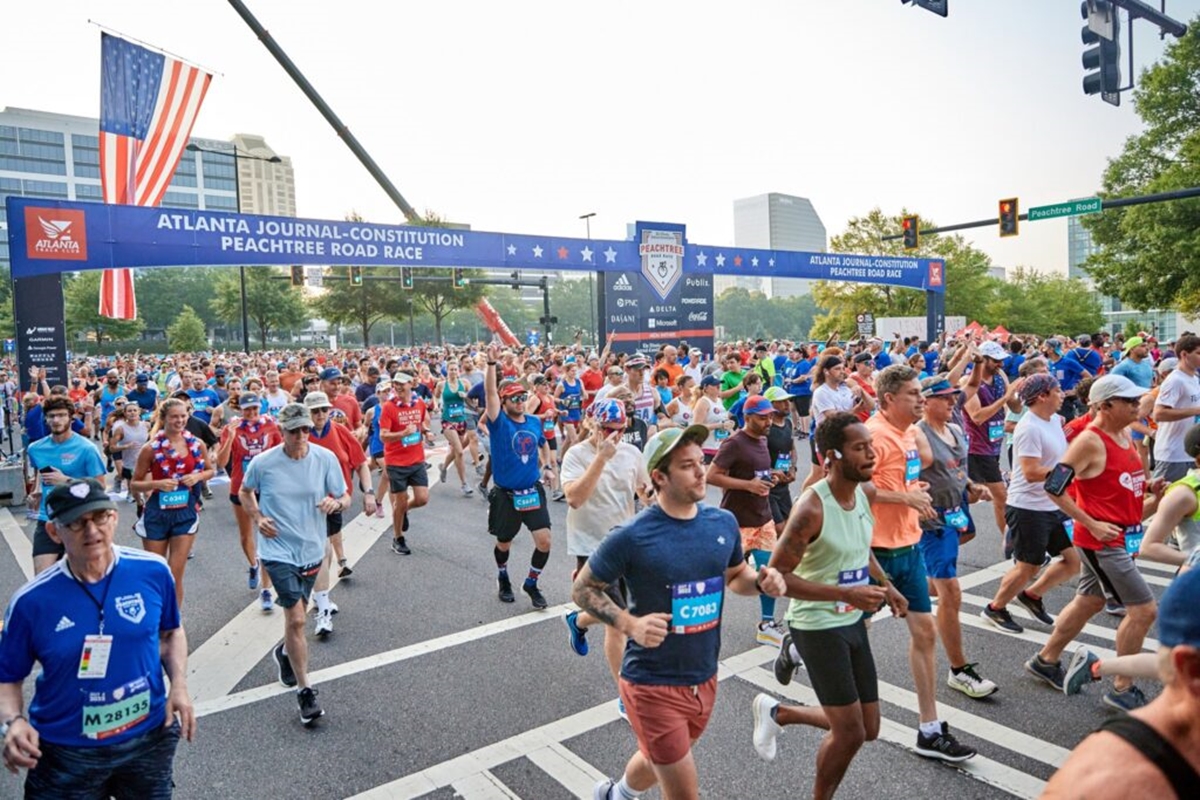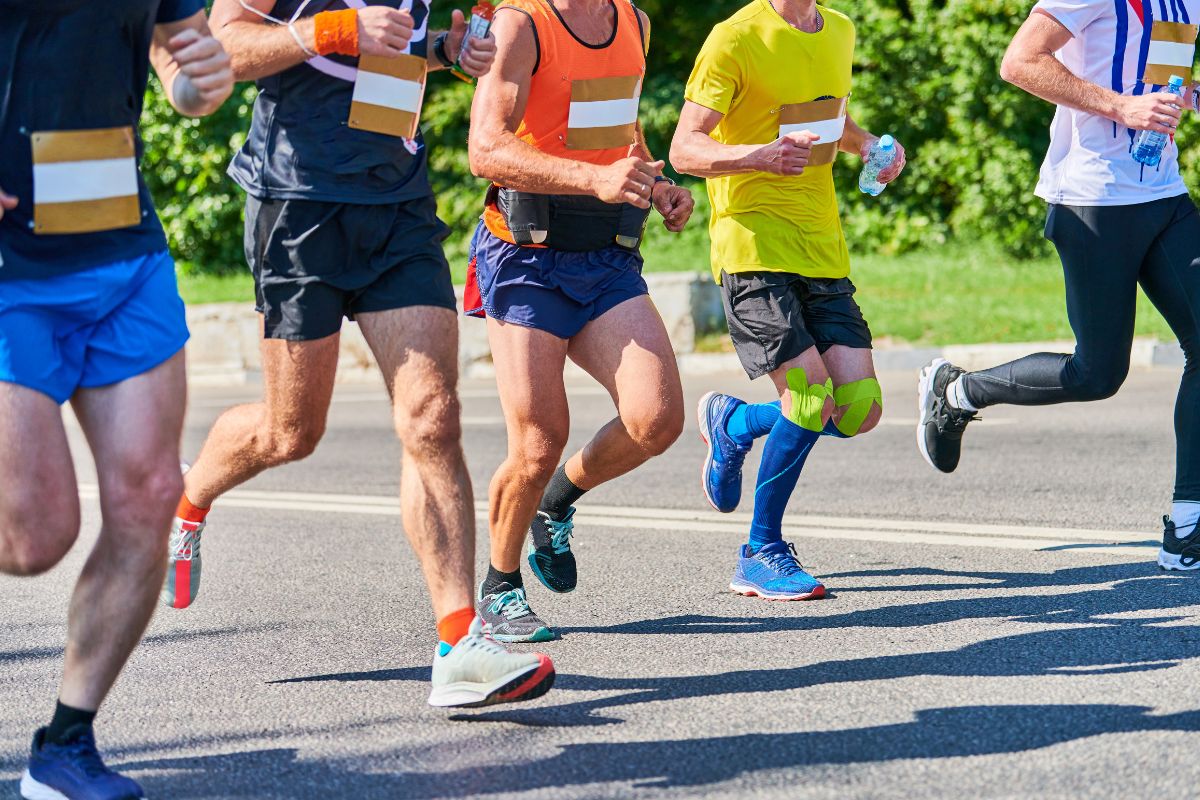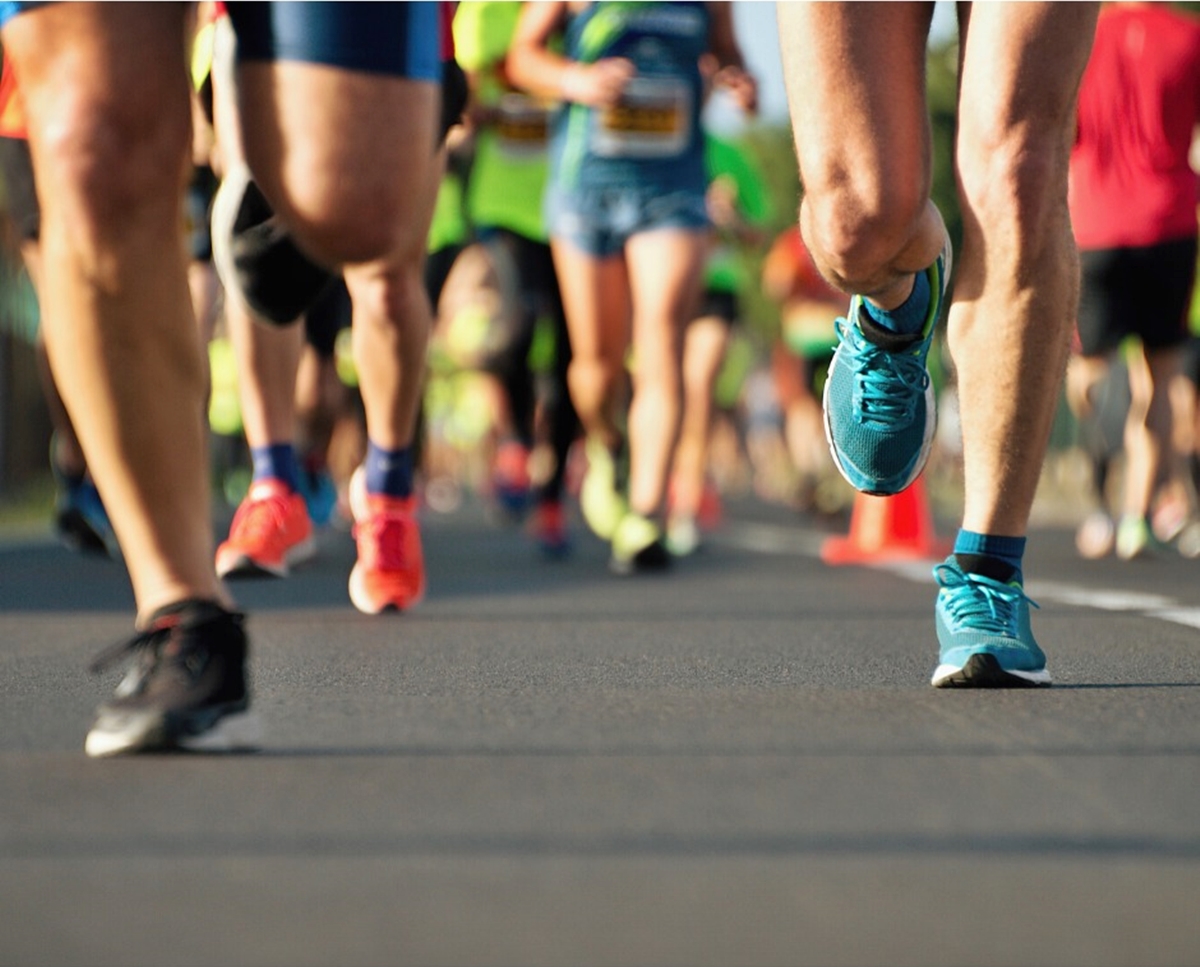Home>Misc>Featured>How Many Calories Does A Half Marathon Burn


Featured
How Many Calories Does A Half Marathon Burn
Modified: August 21, 2023
Discover how many calories you can burn during a half marathon. Get featured tips on maximizing your calorie burn and achieving your fitness goals.
Introduction
Welcome to the world of long-distance running! If you’ve ever thought about participating in a half marathon, you’re in for an incredible experience. Not only is it a great way to challenge yourself physically and mentally, but it can also have a significant impact on your overall health and fitness goals.
One question that often arises when considering any form of exercise is how many calories can be burned. Whether you’re aiming to shed a few pounds or simply maintain a healthy weight, understanding the caloric expenditure of activities is crucial. In this article, we will explore the question, “How many calories does a half marathon burn?” to give you a better understanding of the benefits of this high-intensity endurance event.
First, let’s have a brief overview of calories and weight loss. Calories are units of energy that our bodies burn to fuel various activities throughout the day. When we consume more calories than we burn, our bodies store the excess as fat, leading to weight gain. On the flip side, when we burn more calories than we consume, our bodies tap into stored fat, resulting in weight loss. So, the key to weight management is creating a calorie deficit by either consuming fewer calories, increasing physical activity, or, ideally, a combination of both.
To better understand the caloric expenditure during exercise, it’s important to know that our bodies use energy from two main sources: fats and carbohydrates. The intensity and duration of exercise determine the ratio of these energy sources. Low-intensity exercises primarily utilize fat as fuel, while high-intensity exercises primarily rely on carbohydrates.
Now, you might be wondering, “Why is the half marathon considered a high-calorie burning activity?” The answer lies in the distance and duration of the event. A half marathon covers a distance of 13.1 miles (21.1 kilometers) and typically takes most runners about 1.5 to 3 hours to complete. This extended period of sustained effort requires a significant amount of energy expenditure, making it an excellent calorie-burning activity.
Calculating the exact number of calories burned during a half marathon can be challenging, as it depends on various factors such as age, weight, gender, running pace, and even the terrain. However, there are some general formulas and guidelines that can give us an estimate of the caloric expenditure. We will explore those in upcoming sections.
Understanding Calories and Weight Loss
Before we dive into the specifics of how many calories a half marathon burns, let’s take a moment to understand the relationship between calories and weight loss. Calories are essentially units of energy that our bodies use to fuel various physiological processes and physical activities.
When it comes to weight loss, the basic principle is simple – to lose weight, you need to create a calorie deficit. In other words, you need to burn more calories than you consume. This imbalance between energy intake and expenditure leads to the body tapping into stored fat to meet its energy needs, resulting in weight loss over time.
It’s important to note that weight loss is not solely determined by calorie deficit. Other factors, such as genetics, metabolism, hormonal balance, and overall dietary quality, also play a role. However, in the context of calories and weight management, creating a calorie deficit is a fundamental principle to keep in mind.
To give you a better idea of the numbers, it’s generally recommended that a pound of body weight equals about 3,500 calories. Therefore, if you aim to lose one pound per week, you would need to create a calorie deficit of approximately 500 calories per day. This can be achieved through a combination of dietary changes and physical activity.
Now, let’s explore the specific role that exercise, such as a half marathon, plays in this equation. Exercise is a powerful tool for burning calories and increasing your overall energy expenditure. Different forms of physical activity have varying levels of intensity and duration, which in turn impact the number of calories burned.
It’s worth noting that the total number of calories burned during exercise is influenced by several factors, including your weight, age, gender, fitness level, and the type of exercise performed. Higher body weight and intensity of exercise generally result in a greater calorie burn.
When it comes to comparing different types of exercises, endurance activities like running, cycling, or swimming tend to be highly effective for calorie burning. These activities typically involve continuous movement over an extended period, thereby expending a significant amount of energy.
Running a half marathon, which covers a distance of 13.1 miles, is no easy feat. The duration and intensity of the race make it an excellent calorie-burning activity. However, to get a more precise estimation of the number of calories burned during a half marathon, we need to consider several factors, which we will explore in the upcoming sections.
Energy Expenditure during Exercise
Understanding how our bodies expend energy during exercise is crucial when trying to determine the number of calories burned during a half marathon. The energy expenditure, commonly measured in calories, is influenced by various factors such as exercise intensity, duration, body weight, and individual fitness level.
When we engage in physical activity, our bodies require energy to power our muscles and sustain the effort. This energy comes from the breakdown of stored carbohydrates and fats, which are then converted into ATP (adenosine triphosphate), the primary source of energy for our cells.
Exercise intensity plays a significant role in determining the proportion of energy derived from carbohydrates and fats. Low-intensity activities, such as walking or gentle cycling, rely primarily on fat stores for fuel. As the intensity increases, our bodies switch to using more carbohydrates as they provide a quicker source of energy. High-intensity activities, like running a half marathon, predominantly utilize carbohydrates as the primary energy source.
Duration is another crucial factor that affects energy expenditure. When engaging in prolonged exercise, our bodies gradually deplete stored carbohydrates, forcing them to rely more on fat stores for energy. This shift to fat metabolism is one reason why endurance activities, such as long-distance running, are considered effective for burning calories and promoting fat loss.
Body weight also plays a role in energy expenditure. Individuals with higher body weight generally burn more calories during exercise due to the increased effort required to move their bodies. For example, a heavier person will burn more calories running a mile than a lighter person running the same distance at the same pace.
Furthermore, individual fitness levels influence the efficiency of energy expenditure during exercise. Regular training and improved cardiovascular fitness enable the body to deliver oxygen more efficiently to the working muscles, enhancing energy utilization and reducing the perceived effort of the activity.
It’s important to note that our bodies continue to burn calories even after exercise, due to a phenomenon known as excess post-exercise oxygen consumption (EPOC). EPOC is the increased rate of oxygen consumption that occurs after intense physical activity to restore the body to its pre-exercise state. This means that, even after completing a half marathon, your body continues to burn calories at a slightly elevated rate during the recovery period.
While understanding energy expenditure during exercise is essential, it’s important to remember that the exact number of calories burned during a half marathon can vary significantly from person to person. In the next section, we will explore the factors that can affect the calorie burn and discuss methods for calculating your individualized estimate.
Factors Affecting Calories Burned
When it comes to calculating the number of calories burned during a half marathon, it’s essential to consider several factors that can influence the calorie expenditure. These factors include age, weight, gender, running pace, and even the terrain on which the race is conducted.
Age plays a role in calorie burn because our metabolism naturally slows down as we get older. This means that younger individuals tend to have a higher metabolic rate and therefore may burn calories more efficiently during exercise.
Weight is a significant factor in determining energy expenditure during any exercise, including running. Heavier individuals require more energy to perform the same physical activity, resulting in a higher calorie burn. Therefore, a person with a higher body weight may burn more calories during a half marathon compared to someone with a lower weight.
Gender can also influence caloric expenditure. On average, men tend to have a higher muscle mass and lower body fat percentage than women, which typically results in a higher metabolic rate. As a result, men may burn more calories during exercise, including running a half marathon, compared to women of the same weight and fitness level.
Running pace is another critical factor that impacts the calorie burn during a half marathon. The faster you run, the more calories you will burn. Running at a higher intensity requires more energy and engages larger muscle groups, resulting in a higher calorie expenditure. It’s important to note that running at a comfortable pace for your fitness level is crucial for avoiding injury and ensuring an enjoyable experience.
The terrain on which the half marathon takes place can also affect the number of calories burned. Running on a hilly course requires more effort due to the additional uphill climbs and downhill descents. This increased effort can result in a higher calorie burn compared to running on a flat surface.
Although we can consider these factors individually, it’s important to recognize that they interact with one another, making it challenging to determine an exact number of calories burned during a half marathon. To get a more accurate estimation, we can use various methods and formulas, which we will explore in the next section.
The Half Marathon: A High-Calorie Burning Activity
When it comes to high-calorie burning activities, participating in a half marathon ranks near the top of the list. This endurance event, spanning a distance of 13.1 miles (21.1 kilometers), requires sustained effort over an extended period, making it an excellent calorie-burning activity.
The combination of distance and duration in a half marathon demands a significant amount of energy expenditure. Running or even walking this distance pushes your body to work at an elevated intensity, leading to a higher calorie burn compared to shorter activities.
During a half marathon, your body relies heavily on carbohydrates as its primary energy source. The intensity of the activity triggers the breakdown of glycogen, the stored form of carbohydrates in your muscles and liver, supplying the necessary energy for each step.
With the continuous movement and elevated heart rate, you engage large muscle groups throughout your body. The major muscles involved in running, such as the quadriceps, hamstrings, calves, and glutes, consume a substantial amount of energy. The more muscle mass involved, the higher the calorie burn.
Running a half marathon also increases your cardiovascular endurance. The sustained effort puts your heart and lungs to work, increasing your heart rate and respiratory rate. This cardiovascular demand not only burns calories during the activity but also contributes to an elevated metabolic rate afterward, allowing you to continue burning calories even during recovery.
Another factor that contributes to the high-calorie burn in a half marathon is the overall intensity of the event. People participating in half marathons often strive for personal bests or enjoy the challenge of pushing their limits. As a result, they tend to run at a higher pace, which translates into a greater calorie expenditure.
It’s important to note that the number of calories burned during a half marathon can vary significantly based on individual factors such as age, weight, gender, running pace, and fitness level. However, on average, running a half marathon can burn anywhere from 1,000 to 2,000 calories or more. Keep in mind that these are rough estimates, and using specific calculation methods can lead to a more precise estimation.
Now that we have established that a half marathon is a high-calorie burning activity, let’s delve into the methods and formulas used to calculate the calories burned during this endurance event.
Calculating Calories Burned in a Half Marathon
Estimating the exact number of calories burned during a half marathon can be challenging, as it depends on various factors such as age, weight, gender, running pace, and even the terrain. However, there are some general formulas and guidelines that can help provide an estimate of the caloric expenditure.
One widely used method to calculate calories burned during running is the MET (Metabolic Equivalent of Task) method. MET represents the ratio of the metabolic rate during an activity compared to the resting metabolic rate. Running at a moderate pace typically has a MET value of 8-10, while running at a faster pace may have a MET value of 12 or higher.
To calculate the calories burned using the MET method, you can multiply your body weight (in kilograms) by the MET value of the activity and the duration of the exercise (in hours). This will give you an estimate of the total calories burned during that time.
For example, let’s say you weigh 70 kilograms and complete a half marathon in 2.5 hours, running at a pace that has a MET value of 10. You can calculate the calories burned as follows:
Calories burned = body weight (kg) x MET value x duration (hours)
= 70 kg x 10 MET x 2.5 hours
= 1,750 calories
It’s important to remember that this method provides an estimation, and individual variations may exist. Other factors such as age, fitness level, and metabolism can influence the actual caloric expenditure.
Another method to calculate calories burned is by using online calculators or fitness tracking devices. These tools take into account factors like age, weight, gender, and activity intensity to provide a more personalized estimation. While these calculators can be helpful, it’s essential to remember that they are still estimates and may not be entirely accurate for everyone.
Regardless of the method used, it’s important to approach these calorie calculations with a flexible mindset. The priority of participating in a half marathon should be the joy of the experience, personal growth, and achieving your personal goals, rather than solely focusing on the number of calories burned.
Now that we have explored various ways to estimate calories burned during a half marathon, let’s delve into some tips to maximize your calorie expenditure during this endurance event.
Tips for Maximizing Calorie Burn during a Half Marathon
A half marathon is not only a great challenge and accomplishment but also a fantastic opportunity to burn a significant number of calories. Here are some tips to help you maximize your calorie burn during this endurance event:
- Train with interval workouts: Incorporate interval training into your running routine. Alternating between periods of high-intensity running and recovery can increase your overall calorie expenditure and improve cardiovascular fitness.
- Increase your running pace: Push yourself to run at a faster pace during your training runs and the actual race. Running at a higher intensity increases your calorie burn, making your half marathon a more effective workout.
- Optimize your running form: Focus on maintaining good running form throughout the race. Proper posture, relaxed shoulders, and a slight lean forward can help you conserve energy and run more efficiently.
- Include strength training: Incorporate strength training exercises into your training routine. Building lean muscle mass can increase your metabolic rate, leading to more calories burned even at rest.
- Stay hydrated: Hydration is essential for optimal performance and calorie burn. Make sure to drink enough water before, during, and after the race to maintain proper hydration levels.
- Eat a balanced pre-race meal: Fueling your body properly before the half marathon is crucial. Consume a meal that includes complex carbohydrates, lean protein, and healthy fats to provide sustained energy throughout the race.
- Consider fueling during the race: If you anticipate running for more than an hour, consider consuming energy gels or snacks during the race to replenish your glycogen stores and maintain your energy levels.
- Focus on recovery: After the race, prioritize proper recovery to support muscle repair and overall well-being. This includes activities such as gentle stretching, foam rolling, and adequate rest.
- Continue regular exercise: Keep in mind that your calorie burn doesn’t stop after the half marathon. Maintaining an active lifestyle and engaging in regular exercise will help you continue burning calories and supporting your overall health and fitness goals.
Remember, participating in a half marathon is not just about the calorie burn. It’s an opportunity to challenge yourself, push your limits, and celebrate your achievements. Enjoy the process, embrace the experience, and savor every moment of your half marathon journey!
Conclusion
Participating in a half marathon is not only a remarkable feat of endurance but also an excellent way to burn calories and support your weight loss or fitness goals. This high-intensity endurance event challenges your body while providing numerous health benefits.
Throughout this article, we have explored the factors that influence how many calories are burned during a half marathon. We discussed the importance of creating a calorie deficit for weight loss, the energy expenditure during exercise, and the factors that can affect calorie burn, such as age, weight, gender, running pace, and terrain.
While precise calculations of calories burned during a half marathon can be challenging, using methods like the MET method or online calculators can provide estimates. However, it’s important to approach these calculations with flexibility, as individual variations exist and the primary focus should be on the overall experience and personal achievement of completing a half marathon.
To maximize your calorie burn during a half marathon, incorporate interval workouts, increase your running pace, optimize your running form, and include strength training in your routine. Staying hydrated, eating a balanced pre-race meal, and considering fueling during the race are also key factors to consider. Additionally, focusing on recovery and maintaining an active lifestyle even after the race is essential for continued calorie burn and overall well-being.
Remember, while burning calories is an important aspect of a half marathon, the personal growth, sense of achievement, and the joy of the experience are equally significant. Embrace the journey, set realistic goals, and enjoy the process of training and racing.
So, lace up your running shoes, prepare for the challenge, and embark on the unforgettable journey of a half marathon – not only for the calorie burn but also for the incredible sense of accomplishment and the positive impact on your overall health and well-being.








